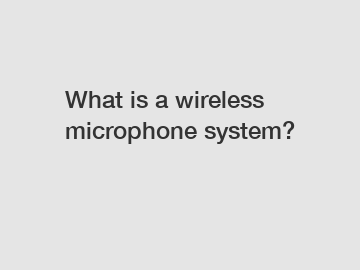What is a wireless microphone system?
Welcome to our comprehensive guide on wireless microphone systems! Being at the forefront of audio technology, these devices have revolutionized the world of live performances, presentations, and public speaking by providing seamless communication, untethered mobility, and crystal-clear sound quality. In this blog post, we will delve into the intricacies of wireless microphone systems, shedding light on their functionality, advantages, and the factors to consider when choosing the perfect system for your needs. Let's embark on this auditory adventure together!
Understanding Wireless Microphone Systems:
A wireless microphone system is a sophisticated audio setup that enables performers, speakers, and presenters to move freely while transmitting their voice wirelessly to a receiver. It comprises three primary components: the microphone itself, a transmitter, and a receiver. The wireless transmitter captures the audio signal from the microphone, which is then transmitted via radio frequencies to the receiver. The receiver, in turn, fetches the signal and relays it to the amplification or sound system, leaving the performer or speaker unburdened by cords or cables.

The Advantages of Going Wireless:
1. Enhanced Mobility: One of the greatest advantages of wireless microphone systems is the freedom of movement they provide. Performers and speakers can roam across the stage or venue, interact with the audience, and deliver powerful performances without worrying about tripping over wires or being limited to a stationary position.
2. Uncompromised Sound Quality: Cutting-edge wireless microphone systems employ advanced technology to ensure exceptional audio quality. These systems offer a wider frequency response range, reduced interference from external sources, and improved signal-to-noise ratio, resulting in clear and distortion-free sound reproduction.
3. Simplified Setup: Traditional wired microphones demand extensive wiring and careful cable management. Conversely, wireless microphone systems streamline the installation process, saving time and minimizing the risk of accidents. Setup involves merely pairing the transmitter and receiver devices, allowing users to focus on their performances instead of intricate technical configurations.
Choosing the Perfect Wireless Microphone System:
When selecting a wireless microphone system, several crucial factors should be considered to ensure optimal performance.
1. Frequency Range: Choose a system that operates within a frequency range compatible with your region's regulations. While most regions have assigned specific frequency bands for wireless microphone use, some bands may be crowded or restricted due to the proliferation of wireless devices. Therefore, research and select a system that guarantees interference-free performance in your area.
2. Diversity Receivers: Opt for a system equipped with diversity receivers. These receivers use multiple antennas to minimize signal dropouts caused by interference or environmental factors. By automatically selecting the strongest signal, diversity receivers ensure uninterrupted audio transmission, crucial for any professional performance.
3. Battery Life and Charging Options: Consider the battery life of both the transmitter and receiver devices. Longer battery life allows uninterrupted performances without worrying about unexpected power drain. Additionally, explore the available charging options such as dock chargers or USB charging, ensuring consistent and convenient power supply.
4. Microphone Types: Depending on your specific needs, choose between handheld, lapel, or headset microphones. Handheld microphones provide versatility, lapel microphones are ideal for discreet applications, and headset microphones offer hands-free convenience. Opting for a system that offers interchangeable microphone attachments would be advantageous.
Conclusion:
As we conclude our exploration of wireless microphone systems, it becomes evident that these devices have revolutionized the audio industry by breaking the physical barriers between performers, speakers, and their audience. Offering unparalleled mobility, pristine sound quality, and simplified setups, wireless microphone systems have become an indispensable tool for professionals across various disciplines. By carefully considering the frequency range, diversity receivers, battery life, and microphone types, individuals can choose a system that resonates with their unique requirements. Embrace the freedom and embrace the future with wireless microphone systems!
Want more information on conference room monitor, led video wall processor, paperless multimedia congress system? Feel free to contact us.
177
0
0


Comments
All Comments (0)